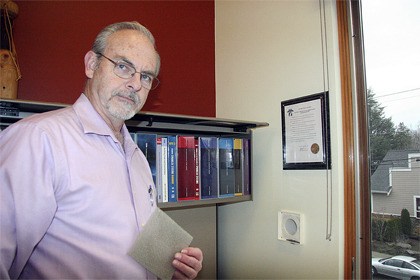Visiting a cubicle at the new Snoqualmie City Hall, city building official Dan Thomason pulled the cover off what looked like a thermostat. Cool, fresh air flowed through.
The unobtrusive little vent is part of Snoqualmie City Hall’s low-impact heating and cooling system, green technology that will help save the city a third of its former heating costs at its administrative headquarters.
The $6 million, 14,000-square-foot building opened on Monday, Dec. 14.
Snoqualmie City Hall’s green design is most evident in what it doesn’t have: air ducts. Air comes into the building to most workspaces through the small wall vents, passing through a coarse filter and a vent cover that keeps workers from being hit by a draft. Employees use an iris to control the amount of outside air that enters, though the flow can’t be shut off completely.
Fans move warm air down from the ceiling in wintertime. Air circulates up and then out of the building.
A radiant floor heating system keeps things warm underfoot. A boiler circulates water through pipes embedded in a couple inches of concrete.
“Once that concrete is heated, it’s easy to keep it heated,” Thomason said. In winter, the pipes run hot; in summer, cool water flows.
“It’s less expensive to run it, because youre not continually trying to heat it,” Thomason said. “Keeping that mass the same temperature saves energy.”
Special glass on the building’s many windows absorbs heat from the sun while keeping out the cold.
The new building’s lights run on a computer system. They automatically turn on or shut off at a given time of the day, saving wastage from lights left on.
City Hall’s new phone system is a first: it puts almost all of the city’s computers and phones on a single network, eliminating duplication.
City Clerk Jodi Warren proudly showed visitors her new grant-funded rolling shelf system. Built on rails, the cabinets consolidates a bank vault and several buildings’ worth of archives.
“We are indexing all of our files, which is something we have never had before,” she said.
As energy costs go down, productivity is expected to go up, as more employees cooperate under one roof.
While the new city hall is not certified as a LEED, or Leadership in Energy and Environmental Design, building, Mayor Matt Larson said efforts were made to get the structure as green as possible. Certifying City Hall as LEED would have cost more than $100,000 extra. Rising costs were a big consideration for the new town hall, which, when it was approved last spring, passed by a single vote.
“We were trying to pick methodologies and approaches that weren’t a whole lot more expensive to employ than conventional,” Larson said. “Our building needs to reflect a different way of using energy. The philosophy on this was to push toward sustainability and an environmentally responsible way of doing things. It makes economic sense, too, if you choose the right priorities.”
While there are sill a number of issues to sort out with the contractor and architect, Larson said the building’s price tag is expected to come in within $50,000 of the original budget.
“I’m very pleased with the building,” the mayor said. “This is going to be part of my administration’s legacy,” as well as the council’s.
“We’re telling the private sector that this is a place worth investing in,” he added.
Indeed, it took quite an investment to put the building in Snoqualmie’s floodplain. Before construction began, engineers brought in an enormous dirt pile to compress the soils, making them firm enough to support a new town hall.
With City Hall placed on a five-foot hollow crawl space to get it above flood level, “the issue became weight,” Larson said. A neo-traditional structure of brick would have been too heavy. That design decision led to the new building’s very modern look, which is meant to echo Mount Si, visible just past Snoqualmie’s historic Methodist Church across River Street.
“This building symbolizies the diverse interests of this community,” Larson said. “Architecture should reflect our time and place. The style has less to do with artistic purpose than pure form and function.”
The new year will see more significant changes downtown. Shovels hit the ground in March on Snoqualmie’s downtown revitalization project, and the Northwest Railway Tribe is beginning work on its new storage facility.
“We’re finally seeing the real stuff come about that we’ve been working on for years,” Larson said.



